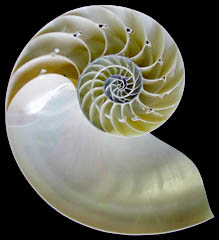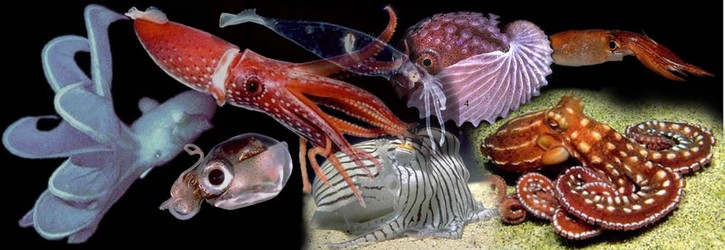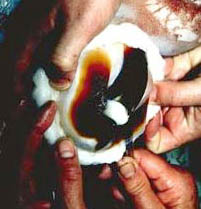Cephalopoda
Octopods, squids, nautiluses, etc.
Richard E. Young, Michael Vecchione, and Katharina M. Mangold (1922-2003)


This tree diagram shows the relationships between several groups of organisms.
The root of the current tree connects the organisms featured in this tree to their containing group and the rest of the Tree of Life. The basal branching point in the tree represents the ancestor of the other groups in the tree. This ancestor diversified over time into several descendent subgroups, which are represented as internal nodes and terminal taxa to the right.

You can click on the root to travel down the Tree of Life all the way to the root of all Life, and you can click on the names of descendent subgroups to travel up the Tree of Life all the way to individual species.
For more information on ToL tree formatting, please see Interpreting the Tree or Classification. To learn more about phylogenetic trees, please visit our Phylogenetic Biology pages.
close boxIntroduction
The Cephalopoda is an ancient and very successful group of the Mollusca. Cephalopods have been among the dominant large predators in the ocean at various times in geological history. Two groups of cephalopods exist today: The Nautiloidea with a few species of the pearly nautilus, and the Coleoidea, containing the squids, cuttlefishes, octopods and vampire squids, which is represented by about 700 species. Cephalopods are the most active of the molluscs and some squids rival fishes in their swimming speed. Although there are relatively few species of living cephalopods, they occupy a great variety of habitats in all of the world's oceans. Individual species are often very abundant and provide major targets for marine fisheries.
Cephalopods first appeared about 500 million years ago in the Upper Cambrian Period. Although considerable uncertainity still exists, the two extant lineages may have separated 470 mya with the possible origin of the Bactritida or earlier. The long separation of the two lineages has, today, resulted in lineages with cephalopods that are very different in structure.
Characteristics
- A funnel derived from the molluscan foot (ref.?) or the molluscan neck region (Shigeno et al., 2007).
- Circumoral arms that are derived from the molluscan head (J.Z. Young, 1965) or the molluscan foot (Shigeno et al., 2007).
- Chitinous beaks.
- Shell.
- Shell with a phragmocone and siphuncle.
 Click on an image to view larger version & data in a new window
Click on an image to view larger version & data in a new window
Figure. A longitudinal cut through the shell of the pearly nautilus (Nautilus sp.)showing the flotation chambers (phragmocone) and the siphuncle (partially lost from the larger chambers) that passes through the septa separating individual chambers. The shell has become internal and highly modified in most living cephalopods. Photograph by R. Young.
- Shell with a phragmocone and siphuncle.
- Image-forming eyes.
Classification
Much of the higher classification of Recent cephalopods is unstable. Various authors have suggested highly varying arrangements. We adopt a conservative arrangement that does not differ much from that of Naef (1921-23). Except for the position of the Octopodiformes and its two orders, we have a questionable phylogenetic basis for accepting this or any other scheme. We suggest, however, for the sake of stability, that the following classification be used until this or an alternative arrangement can be derived from cladistic analyses. The analyses, whether molecular or morphological, however, must be robust and must survive considerable scrutiny before changes in classification should be adopted.
- Class: Cephalopoda Cuvier, 1797
- Subclass: Nautiloidea Agassiz, 1847
- Fam: Nautilidae Blainville, 1825
- Subclass: Coleoidea Bather, 1888
- Division: Neocoleoidea Haas, 1997
- Superorder: Octopodiformes Berthold and Engeser, 1987
- Order: Vampyromorpha Robson, 1929
- Fam: Vampyroteuthidae Thiele, in Chun, 1915
- Order: Octopoda Leach, 1818
- Suborder: Cirrata Grimpe, 1916
- Fam: Cirroteuthidae Keferstein, 1866
- Fam: Stauroteuthidae Grimpe, 1916
- Fam: Opisthoteuthidae Verrill, 1896
- Suborder: Incirrata Grimpe, 1916
- Fam: Amphitretidae Hoyle, 1886
- Fam: Bolitaenidae Chun, 1911
- Fam: Octopodidae Orbigny, 1839 In: Ferussac and Orbigny, 1834-1848
- Fam: Vitreledonellidae Robson, 1932
- Suborder: Cirrata Grimpe, 1916
- Order: Vampyromorpha Robson, 1929
- Superorder: Octopodiformes Berthold and Engeser, 1987
- Division: Neocoleoidea Haas, 1997
- Superfamily: Argonautoidea Naef, 1912
- Fam: Alloposidae Verrill, 1881
- Fam: Argonautidae Cantraine, 1841
- Fam: Ocythoidae Gray, 1849
- Fam: Tremoctopodidae Tryon, 1879
- Superfamily: Argonautoidea Naef, 1912
- Subclass: Nautiloidea Agassiz, 1847
- Superorder: Decapodiformes Leach, 1817
- Interactive KEY to families of the Decapodiformes
- Order: Oegopsida Orbigny, 1845
- Fam: Architeuthidae Pfeffer, 1900
- Fam: Brachioteuthidae Pfeffer, 1908
- Chiroteuthid families
- Fam: Batoteuthidae Young and Roper, 1968
- Fam: Chiroteuthidae Gray, 1849
- Fam: Joubiniteuthidae Naef, 1922
- Fam: Magnapinnidae Vecchione and Young, 1998
- Fam: Mastigoteuthidae Verrill, 1881
- Fam: Promachoteuthidae Naef, 1912
- Fam: Cranchiidae Prosch, 1847
- Fam: Cycloteuthidae Naef, 1923
- Enoploteuthidae families
- Fam: Ancistrocheiridae Pfeffer, 1912
- Fam: Enoploteuthidae Pfeffer, 1900
- Fam: Lycoteuthidae Pfeffer, 1908
- Fam: Pyroteuthidae Pfeffer, 1912
- Fam: Gonatidae Hoyle 1886
- Histioteuthid families
- Fam: Histioteuthidae Verrill, 1881
- Fam: Psychroteuthidae Thiele, 1920
- Lepidoteuthid families
- Fam: Lepidoteuthidae Naef, 1912
- Fam: Octopoteuthidae Berry, 1912
- Fam: Pholidoteuthidae Voss, 1956
- Fam: Neoteuthidae Naef, 1921
- Fam: Ommastrephidae Steenstrup, 1857
- Fam: Onychoteuthidae Gray, 1847
- Fam: Thysanoteuthidae Keferstein, 1866
- Order: Myopsida Naef, 1916
- Fam: Australiteuthidae Lu, 2005
- Fam: Loliginidae Lesueur, 1821
- Order: Sepioidea Naef, 1916
- Suborder: Sepiida Keferstein, 1866
- Fam: Sepiidae Keferstein, 1866
- Suborder: Sepiolida Naef, 1916
- Fam: Sepiadariidae Fischer, 1882
- Fam: Sepiolidae Leach, 1817
- Suborder: Sepiida Keferstein, 1866
- Order: Spirulida Haeckel, 1896
- Fam: Spirulidae Owen, 1836
- Fam: Spirulidae Owen, 1836
- Order uncertain
- Superfamily: Bathyteuthoidea nov.
- Fam: Bathyteuthidae Pfeffer, 1900
- Fam: Chtenopterygidae Grimpe, 1922
- Fam: Idiosepiidae Fischer, 1882
- Superfamily: Bathyteuthoidea nov.
- Order: Oegopsida Orbigny, 1845
References
Shigeno, S., T. Sasaki, T. Moritaki, T. Kasugai, M. Vecchione, & K. Agata. 2008. Evolution of the cephalopod head complex by assembly of multiple molluscan body parts: evidence from Nautilus embryonic development. Journal of Morphology 269:1-17.
Teichert, C. 1988. Main features of cephalopod evolution. p. 11-79. In: (Clarke, M. R. and E. R. Truman, eds.) The Mollusca, 12, Paleontology and Neontology of Cephalopods. Academic Press, Inc., New York. 355 pp.
Teichert, C. 1989. Les principales caractéristiques de l'évolution des céphalopodes. In: Mangold, K., Traité de Zoologie V:715-781.
Young, J. Z. 1965. The central nervous system of Nautilus. Phil. Trans. Royal Soc., Ser. B. 249 (754): 1-25.
The following are major sources of information on cephalopods
Mangold, K. (editor)1989. Céphalopodes. Traité de Zoologie. Anatomie, Systématique, Biologie (P. P. Grassé, editor). Tome 5, Fascicule 4. Masson, Paris, 804 pp.
Naef, A. 1921/23. Cephalopoda. Fauna e Flora del Golfo di Napoli. Monograph, no. 35. English translation: A. Mercado (1972). Israel Program for Scientific Translations Ltd., IPST Cat. No. 5110/1,2.
Nesis, K. N. 1982. Abridged key to the cephalopod mollusks of the world's ocean. 385+ii pp. Light and Food Industry Publishing House, Moscow. (In Russian.). Translated into English by B. S. Levitov, ed. by L. A. Burgess (1987), Cephalopods of the world. T. F. H. Publications, Neptune City, NJ, 351pp.
Young, J. Z. 1971. The Anatomy of the Nervous System of Octopus vulgaris. Claredon Press, Oxford. 690pp.
The following are recent compilations on cephalopods
Abbott, J., R. Williamson, and L. Maddock (editors). 1995. Cephalopod Neurobiology. Oxford University Press, New York. 542 pp.
Beesley, P.L., Ross, G.J.B. & Wells, A. (eds). 1998. Mollusca: The Southern Synthesis. Fauna of Australia. Vol. 5. CSIRO Publishing: Melbourne, Part A 563 pp., Part B 565-1234 pp. Cephalopods presented in Chapters 11, 12, 13, pages 451?563.
Boletzky, S. v. (editor). 1995. Mediterranean Sepiolidae. Bulletin de l'Institut océanographique, Monaco. Special Number 16:105 pp.
Boletzky, S.v., P. Fioroni and A. Guerra (Eds.). 1997. Proceedings of the Second international Symposium on Functional Morphology of Cephalopods. Vie Milieu, 47: 87-187.
Boucaud-Camou, E. (editor). 1991. La Sieche. The Cuttlefish. Centre de Publications de l'Universite de Caen, France, 358 pp.
Boyle, P. R. (editor). 1983. Cephalopod Life Cycles, Volume I, Species Accounts. Academic Press, London, 475 pp.
Boyle, P. R. (editor). 1987. Cephalopod Life Cycles, Volume II, Comparative Reviews. Academic Press, London, 441 pp.
Boyle, P. R. and G. J. Pierce (editors). 1994. Fishery Biology of Northeast Atlantic Squid. Fisheries Res. 21(1-2):314 pp.
Boyle, P. R. (Ed.) 1991. The UFAW handbook on the care and management of cephalopods in the laboratory. Universities Federaton for Animal Welfare, Potters Bar, U.K., 63 pp.
Budelmann, B.U., Schipp, R. and Boletzky, S. von. 1997. Cephalopoda In: Microscopic Anatomy of Invertebrates, Volume 6A, Mollusca II (Harrison, F.W., Kohn, A., Eds.) New York: Wiley-Liss, pp 119-414.
Clarke, M. R. (editor). 1986. A Handbook for the Identification of Cephalopod Beaks. Clarendon Press, Oxford, U.K. 273 pp.
Clarke, M. R., and E. R. Trueman (editors). 1988. The Mollusca. Volume 12. Paleontology and Neontology of Cephalopods. Academic Press, San Diego, 355 pp.
Chotiyaputta, C., E. M. C. Hatfield and C. C. Lu (editors). 2005. Cephalopod biology, recruitment and culture. International Cephalopod Symposium and Workshop, 17-21 Feb. 2003. Research Bulletin, Phyuket Marine Biological Center, No. 66, Published by the Center Phuket, Thailand, July 2005, 365 pp.
Guerra, A. 1992. Mollusca - Cephalopoda. Fauna Iberica, Vol.1 (M.A. Ramos et al., Eds.) Museo Nacional de Ciencias Naturales, CSIC, Madrid,
Gilbert, D. L., W. J. Adelman, and J. M. Arnold (editors). 1990. Squid as Experimental Animals. Plenum Press, NY, 516 pp.
Hanlon, R. T. (editor). 1988. Life History, Systematics and Zoogeography of Cephalopods in Honor of S. Stillman Berry. Malacologia, 29(1).
Hanlon, R. T. And J. B. Messenger. 1996. Cephalopod Behaviour. Cambridge Univ. Press, 232 pp.
Hochberg, F.G. 1990. Diseases of Mollusca: Cephalopoda.1.2 Diseases Caused by Protistans and Metazoans. In O. Kinne (Ed.): Diseases of Marine Animals. Vol. 3.Hamburg: Biologische Anstalt Helgoland, pp. 47-227.
Jereb, P., S. Ragonese, And S. Von Boletzky (editors). 1991. Squid Age Determination Using Statoliths. Note Tecniche e Reprints dell'Istituto di Tecnologia della Pesca e del Pescato (Mazara del Vallo, Italy), Special Publication 1:127 pp.
Jereb, P. and Roper, C.F.E. (editors). 2005. Cephalopods of the world. An annotated and illustrated catalogue of species known to date. Volume 1. Chambered nautiluses and sepioids (Nautilidae, Sepiidae, Sepiolidae, Sepiadariidae, Idiosepiidae and Spirulidae). FAO Species Catalogue for Fishery Purposes. No. 4, Vol. 1. Rome, FAO. 260 pp. 9 colour plates.
Kinne, O. (Ed.). 1990. Diseases of Marine Animals. Vol. III. (Cephalopoda through Urocordata). Biologische Anstalt Helgoland, Hamburg. pp. 21-227.
Koueta, N., J.P. Andrade, S. v. Boletzky. 2006. The cuttle Sepia officinalis. Vie et Milieu - Life & Enironment, 56 (2).
Landman, N. H., K. Tanabe and R. A. Davis (editors). 1996. Ammoniod Paleobiology. Plenum Press, NY, 857 pp.
Moynihan, M. And A. F. Rodaniche. 1982. The Behavior and Natural History of the Caribbean reef Squid Sepioteuthis sepioidea. Advances in Ethology 25, Supplement 25 to J. Comp. Ethology. Verlag Paul Parey, Berlin. 151 pp.
Nixon, M. And J. B. Messenger (editors). 1977. The Biology of Cephalopods. Symp. Zool. Soc. Lond. 38:615 pp.
Nixon, M. & Young, J.Z. (2003). The brain and lives of Cephalopods. Oxford University Press, UK, 448 pp.
Norman, M.D. 2000. Cephalopods: A world guide. Conch Books, Hackenheim, 320 pp.
Northwest Atlantic Fisheries Organization. 1985. Special Session on Squids. NAFO Scientific Council Studies 9:175 pp.
Okutani, T., R. K. O'Dor, And T. Kubodera (editors). 1993. Recent Advances in Cephalopod Fisheries Biology. Tokai University Press, Tokyo, 752 pp.
Okutani, T. 1995. Cuttlefish and Squids of the World in Color. National Cooperative Association of Squid Processors (Japan). 185 pp.
Payne, A.G., D, J. Agnew, G.J. Pierce. 2006. Proceedings of the CEPHSTOCK Cephalopod Assessment Workshop. Fisheries Research, 78 (1):1-106.
Pierce, G.J., J.M. Portela, J.-P. Robin (editors). 2005.Environmental effects on cephalopod life history and fisheries. Aquatic Living Resources, 18 (4): 325-400.
Pörtner, H. O. and R. K. O'dor (editors). 1994. Lifestyle and Performance in Cephalopods--Physiological Adaptations. Mar. Freshw. Behav. Physiol. 25(1-3):207 pp.
Rodhouse, P.G., Dawe, E.G. & O?Dor, R.K. (eds.). 1998. Squid recruitment dynamics. The genus Illex as a model, the
commercial Illex species and influences on variability. FAO Fisheries Technical Paper, 376: 273 pp.
Rodhouse, P. G., U. Piatkowski, And C. C. Lu (editors). 1994. Southern Ocean Cephalopods: Life Cycles and Populations. Antarctic Sci. 6(2):135-290.
Rodhouse, P.G., Yamashiro, C. & Goss, C. (eds.). 2001. Squid fishery biology in the Eastern Pacific coastal upwelling system. Fisheries Research, Special Issue, 54 (1): 143 pp.
Roper, C. F. E., C. C. Lu, And F. G. Hochberg (editors). 1983. Biology and Resource Potential of Cephalopods. Mem. Natl. Mus. Victoria 44:311 pp.
Roper, C. F. E., and M. Vecchione (editors). 1991. The Gilbert L. Voss Memorial Issue. Bull. Mar. Sci. 49(1-2):670 pp.
Saunders, W. B., And N. H. Landman (editors). 1987 . Nautilus. The Biology and Paleobiology of a Living Fossil. Plenum Press, NY. 632 pp.
Sweeney, M. J., Roper, C. F. E., Mangold, K. M., Clarke, M. R. & Boletzky, S. v. (editors). 1992. "Larval" and Juvenile Cephalopods: A manual for their identification. Smithson. Contr. Zool. 513:282 pp.
Tomiyama, T. and T. Hibiya. Fisheries in Japan, Squid and Cuttlefish. Japan Marine Products Photo Material Association, Tokyo. 161 pp.
Voss, N. A., M. Vecchione, R. B. Toll and M. J. Sweeney (editors). 1998. Systematics and biogeography of cephalopods. Smithson. Contr. Zool. Vols. I and II, No. 513: 1-599.
Ward, P. D. 1987. Natural History of Nautilus. Allen and Unwin, London. 268 pp.
Wells, M. J. 1978. Octopus. Physiology and Behavior of an Advanced Invertebrate. London. Chapman and Hall.
Wiedmann, J., And J. Kullmann (editors). 1988. Cephalopods Past and Present. E. Schweizerbart'sche Verlagsbuchhandlung, Stuttgart, Germany, 765 pp.
Information on the Internet
Additional information of cephalopods can be found at the following web sites:
- Interactive KEY to families of the Decapodiformes
- Cephalopods at the National Museum of Natural History
- Smithsonian cephalopod bibliography
- CIAC WWW home page
- International Directory of Cephalopod Workers.
- Eurosquid WWW home page
- Encyclopedia of Life, Cephalopoda
- Major cephalopod references on the web:
- Smithsonian Giant Squid electronic exhibition
- Laboratory of Roger Hanlon
- TONMO.com: The Octopus News Magazine Online
- James Wood's Cephalopod WWW page
- Squid fishing community
- GLOBEFISH: Squid Market Report
Title Illustrations

- Histioteuthis pacifica Hawaii. (Photograph copyright ? 1996, R. E. Young).
- Cirroteuthis magna (?) off Hawaii (courtesy of Alex Malahoff; photograph copyright ? 1996, Hawaii Undersea Research Laboratory).
- Octopus ornatus, Great Barrier Reef (photograph copyright ? 1996, Mark Norman).
- Argonauta nodosa juvenile, 58 mm shell length, captured off Melbourne (photograph copyright ? 1996, David Paul).
- Sepioloidea lineolata, off south Australia (photograph copyright ? 1998, Mark Norman).
- Iridoteuthis iris, off Hawaii, about 18 mm ML (photograph copyright ? 1996, Thomas Burch).
- Nototodarus hawaiiensis, off Hawaii (photograph copyright ? 1996, R. E. Young)
- Leachia pacifica, off Hawaii (photograph copyright ? 1996, R. E. Young)
About This Page
The initial Tree-of-Life pages for the Cephalopoda were prepared by R. E. Young, K. M. Mangold and M. Vecchione. Feedback from readers regarding errors, mistakes and omissions, will be appreciated as will suggestions for and contributions of photographs.
For an overview of the people working on the ToL Cephalopoda branch, see ToL Scientific Contributors for Cephalopoda
Richard E. Young

University of Hawaii, Honolulu, HI, USA

National Museum of Natural History, Washington, D. C. , USA
Katharina M. Mangold (1922-2003)

Laboratoire Arago, Banyuls-Sur-Mer, France
Page copyright © 2010 Richard E. Young, , and Katharina M. Mangold (1922-2003)
 Page: Tree of Life
Cephalopoda . Octopods, squids, nautiluses, etc..
Authored by
Richard E. Young, Michael Vecchione, and Katharina M. Mangold (1922-2003).
The TEXT of this page is licensed under the
Creative Commons Attribution-NonCommercial License - Version 3.0. Note that images and other media
featured on this page are each governed by their own license, and they may or may not be available
for reuse. Click on an image or a media link to access the media data window, which provides the
relevant licensing information. For the general terms and conditions of ToL material reuse and
redistribution, please see the Tree of Life Copyright
Policies.
Page: Tree of Life
Cephalopoda . Octopods, squids, nautiluses, etc..
Authored by
Richard E. Young, Michael Vecchione, and Katharina M. Mangold (1922-2003).
The TEXT of this page is licensed under the
Creative Commons Attribution-NonCommercial License - Version 3.0. Note that images and other media
featured on this page are each governed by their own license, and they may or may not be available
for reuse. Click on an image or a media link to access the media data window, which provides the
relevant licensing information. For the general terms and conditions of ToL material reuse and
redistribution, please see the Tree of Life Copyright
Policies.
- First online 16 November 1996
- Content changed 03 May 2010
Citing this page:
Young, Richard E., Michael Vecchione, and Katharina M. Mangold (1922-2003). 2010. Cephalopoda . Octopods, squids, nautiluses, etc.. Version 03 May 2010 (under construction). http://tolweb.org/Cephalopoda/19386/2010.05.03 in The Tree of Life Web Project, http://tolweb.org/








 Go to quick links
Go to quick search
Go to navigation for this section of the ToL site
Go to detailed links for the ToL site
Go to quick links
Go to quick search
Go to navigation for this section of the ToL site
Go to detailed links for the ToL site